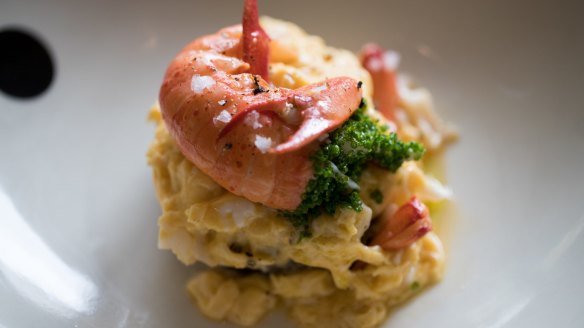How do cafes get their scrambled eggs so creamy?
How do cafes get their scrambled eggs so creamy? K. Whitehead
Cream. Cream and butter. Cream and butter and salt. Now if you are worried about your heart health, visit heartfoundation.org.au. But if you want to know how to make those creamy eggs take six large eggs, the yolks of two eggs, ¾ teaspoon salt, 30 grams of chilled butter cut into little cubes and 30 millilitres of cream. In a bowl beat the eggs, yolks and salt for a minute then let it rest for 15 minutes. Add the butter, and pour the mixture into a medium non-stick pan. Cook over a medium-low heat, stirring continuously with a wooden spoon, until the butter melts and the eggs begin to thicken and form curds. Remove from the heat and add the cream and stir until mixed well. Pile on to enough toast to feed four. See your doctor if pain persists.

Why do the Spanish put salt on chocolate? M. Ellis
Why is Spanish coffee so appalling? Why are there concrete villages in the middle of nowhere dotted across Spain? All because of one man. Francisco Franco Bahamonde. More or less. Dictator of Spain from 1937 to 1975, his fascist regime saw the Iberian nation isolated behind what is sometimes referred to as the Jamon Curtain. Franco created a transmigration program that saw people move from every corner of the country into instant concrete villages. International trade was limited and cheap robusta coffee was imported into Spain. With low acidity and high bitterness, it was dark-roasted to give more flavour – a coffee culture that remains today in Spain. Something similar occurred with chocolate. Dark, quite bitter chocolate was served with dry bread, a little olive oil and sprinkled with salt as dessert. Salt suppresses our tastebuds' ability to detect bitterness. Sprinkle a little salt on something that tastes bitter and it will begin to taste sweeter. If you have drinking chocolate in the cupboard, read the ingredients. The third ingredient is often salt.
What causes holes in cheese? G. Coulter
Gas. Carbon dioxide to be precise. Take a cheese like emmental. During maturation, the large wheels of this delicious cheese are moved to a warmer cellar with lower humidity. These conditions favour carbon dioxide producing propionic bacteria. Unable to escape through the curd, the gas forces bubble-like shapes, referred to as eyes, to form within the cheese. The bacteria also produce other compounds that give the cheeses their particular aromas. Once thought to be a cheesemaking fault, the eyes are now a hallmark of Swiss emmental and other cheeses such as Dutch maasdam, Italian fontina and Norwegian jarlsberg. There has been a problem with decreasing hole size in Europe over recent decades. One theory has it that propionic bacteria have traditionally been introduced to milk via microscopic particles of hay used for cattle bedding. As the dairies modernised and became more hygienic, there were fewer ways for the hay particles to enter the food stream.
Send your vexing culinary conundrums to brainfood@richardcornish.com.au or tweet to @Foodcornish
